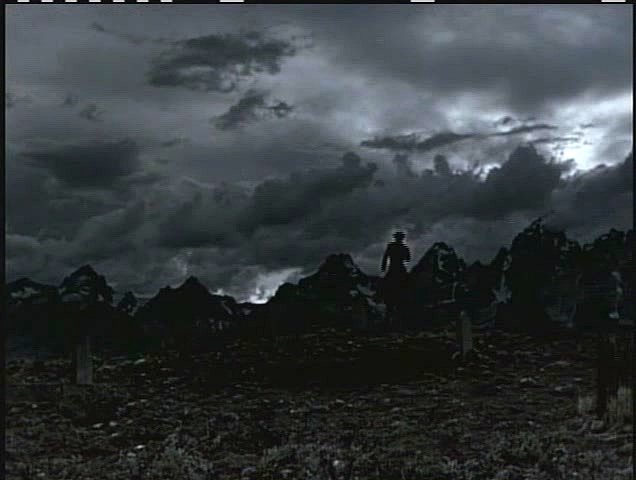THE American WESTERN
By Jeffrey-Baptiste Tarlofsky
By Jeffrey-Baptiste Tarlofsky
Lesson 21 consists of 8 video lectures and transcripts of those lectures, and 7 film excerpts. Start with Excerpt 1 and continue down the page in sequence until you reach the end of the lesson.
レッスン21は、8本のビデオレクチャー(レクチャーのテキストがビデオレクチャーの下に記載されています)と7本の動画で構成されています。
このレッスンは、最初のExcerpt #1 から順番に動画を見たりテキストを読んでください。
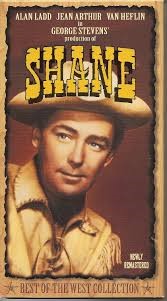
Directed & Produced by: George Stevens
Screenplay by: A.B. Guthrie Jr and Jack Sher
Based on: Shane 1949 novel by Jack Schaefer
Starring: Alan Ladd, Jean Arthur, Van Heflin, Brandon deWilde, Jack Palance
Music by: Victor Young
Cinematography: Loyal Griggs
Running time: 118 minutes
Part 1 – This is a very emotional scene that begins with the Rikers and Wilson, the men responsible for killing Torrey, coming out of the saloon to listen to the homesteaders sing a hymn in the cemetery on the hill as they prepare to bury Torrey. All the homesteaders are there because Joe Starrett has once again brought them all together.
The homesteaders have neither a church nor a minister. This community is only two years old and even that most basic part of civilization has not yet been built. Nor do they yet have a school or teacher for their children. These people have no extra money to build churches or schools as of yet. We can also see how poor these people are by the poverty of Torrey’s casket It is just rough-hewn wood nailed together into a crude box; a poor man’s coffin. But while Torrey may have been a poor man in material terms, he is “rich” in friends who mourn his death. One of them is Yank Potts, the man who always made it a joke to play “Dixie” (the anthem of the Southern Confederacy) on his harmonica when Torrey was angry or excited. Potts isn’t joking now. As Torrey’s coffin is lowered into the Earth, Potts plays Dixie for Torrey for the last time. He plays it slowly and with sincere feeling.
This moment in Shane reminds me of the scene in Stagecoach in which the southerner, Hatfield, shot by the Indians, dies in the arms of the Northerner, Doc Boone. They are old enemies, but the war was long over and they become “brothers” once again. Now that Torrey is dead, Yank Potts is showing his deep respect for his fallen brother by playing Dixie. Potts then plays “taps” (an incredibly solemn piece of music which both the North and South played at soldiers’ funerals during the Civil War). As Potts plays, Torrey’s dog whimpers and paws at the casket while his widow weeps. Young Joey moves away from the casket and starts to pat a baby horse. All of these small details are used by George Stevens almost as if he were a painter adding detail after detail to his painting just to enrich the scene and make us think about what we are seeing. John Ford was a master of landscapes and character portraits, but George Stevens is a master of small details.
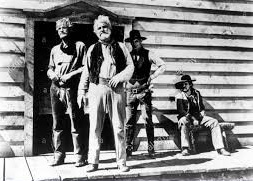

As dirt is shoveled over Torrey’s casket, Stevens pans from the mourners on the hill to the saloon, and the music shifts to Victor Young’s “sinister” theme. Stevens cuts to a shot of the Rikers and Wilson and the music changes to what I call Young’s “reflective” theme. Why? Remember what I said about Victor Young’s music and how Stevens uses it in the film. The music does far more than just give us a background atmosphere to the action. Young’s music helps explain the thoughts and emotions of the characters. Again and again, I have said that Shane leaves many things “unsaid”. But we still understand these things. One way we understand things that are unsaid is through the music. The “reflective” theme is used to accompany shots of Chris Calloway sitting in front of the saloon. This is the third time Stevens has given us a closeup of Calloway sitting there lost in thought. Would you care to guess what Chris Calloway is thinking? Please write your idea in your notes before going to the next excerpt

Part 2 – And now we know what Chris Calloway was thinking about. He was thinking about where he wants to stand in this conflict. He is a cowboy and his natural loyalty would be to his fellow cowboys and the rancher he works for. But he was also beaten by Shane in a fair fight. When the Rikers attacked Shane in the second fight in the saloon Calloway does not take part. The second fight was not a fair fight and the only thing that saved Shane was Joe Starrett suddenly joining the fight. We have said it again and again, a westerner values his honor more than almost anything else and Calloway has seen that the Rikers fight without honor. Calloway also saw that Torrey’s death was nothing more than a murder. Now he has heard the Rikers plan a trap for Joe Starrett and it is simply too much for him.
He will not sit by and allow another man to be murdered. He tells Shane “Starrett is up against a stacked deck” (to “stack the deck” means to arrange the cards so you can cheat). Calloway goes from being one of the main bad guys in the film to a good guy. We had just a hint that he might not be all bad when he went into Grafton’s store to call the bartender before his fight with Shane. He smiles at one of the farm girls who is trying on a hat (and she blushes and takes the hat off). If we noticed that exchange between the cowboy and the farm girl we might have thought,” Hmmm, maybe there is hope that these two sides could come together”. We can easily imagine that after he says “be seeing you” to Shane, Calloway might just ask that girl out for a date.
It doesn’t seem like Chris Calloway’s change of heart is a very important part of the story, but let’s consider what he has done. He has changed his ways. Instead of continuing to be what he was, he has chosen a new path. He has taken his second chance. Isn’t that what Shane is trying to do throughout the film? Shane has taken off his gun and tried to become a farmer.
Part Three – George Stevens has a wonderful understanding of child psychology. Joey has been watching all the events in the film very carefully and somewhere in his mind he knows that there is going to be a gunfight between the “white hats” and the “black hats”. His mother is very upset when she realizes her husband is going to fight Riker, but Joey is excited by the thought of a gunfight because he doesn’t really understand what they are. Joey has never shot a real gun and never shot a living thing. He doesn’t really understand that this isn’t a game. He plays “gunfighter”, but his excitement upsets his mother even more as she faces the reality of losing her husband.
Yet, even in this moment when she might be angry with Joey, Mrs. Starrett is still kind and she gently asks him to go play outside. She is quickly running out of things to say to try to stop her husband from going to town and her final appeal is, “Don’t I mean anything to you? Doesn’t Joey?” Joe Starrett sits with her and says that while he loves and trusts her completely, he also believes she “would be taken care of…maybe better than I could do myself”. Of course, he means that if he dies, Shane will be there to take care of her and Joey…perhaps marry her and become Joey’s father. Remember that he saw her dancing with Shane and saw what a handsome couple they made.
Joe’s saying this lets us know just how much this man really loves his wife and child. He would die for them as long as he thought they would be taken care of. It also lets us know just how deep his friendship with Shane has become because he would let Shane replace him as husband and father. There is no jealousy, just trust in his wife and his best friend.
But Shane has no intention of allowing this to happen.
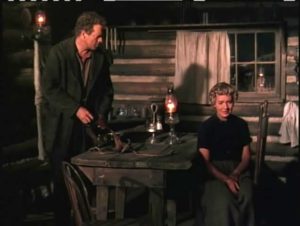
Part 4 – Again, that music of Victor Young’s is there to help tell the story. The music soars as Shane strides to the house wearing his buckskins, silver belt, and gun. He has put the gun back on. Shane took his gun off not just to help the Starretts on their farm, but to change his life, to take his second chance. Now he has put the gun back on not for himself, but for the Starretts. As he says, “this is my kind of game”. But Joe refuses his help. Joe believes he must fight his own fight, but Shane knows “the deck is stacked”. Joe’s stubborn pride won’t let him allow Shane to fight for him and the result is that Shane has to fight Joe to keep him from going to town.
The fight is terrible and reminds us that George Stevens wanted his audience to understand the horror of violence. The animals scream and run away, while Mrs. Starrett also screams and cries out and Joey watches. Joey once asked his father, “Could you beat Shane in a fight?” It was a silly little boy question, but now the reality is that Joe has almost beaten Shane. He has pushed him up against that old tree stump that we know symbolizes the stubborn old man Riker who is the cause of all this conflict. But, Shane knocks Joe out with his gun. It is certainly a dishonorable way to win a fight, but Shane doesn’t care about that so long as he can save Joe.
In one of the most memorable moments of the film, Mrs. Starrett asks Shane, “Are you doing this just for me?”. He says he is doing it for all of them. As he prepares to leave she says, “Please, Shane” and there is a pause before we hear Joey say “Mother?” and she repeats the “please” in a different tone of voice “Please, take care of yourself” and they shake hands!
This is the greatest kiss that never happened in any Western. Wait, didn’t I say that before when we were watching Stagecoach and instead of kissing her Ringo tells Dallas “wait here” while he goes off to fight the Plummer brothers? Now we have Shane going off to a gunfight instead of kissing Mrs. Starrett. It seems Westerns not only left some things unsaid, they also left some things undone.
The suggestion of sexual interest between Shane and Mrs. Starrett has been there ever since Ryker slyly commented to Shane, “Pretty wife Starrett’s got”. Mrs. Starrett is attractive, by far the most attractive woman we see in the film. But George Stevens did not choose one of Hollywood’s great beauties for the role of Mrs. Starrett. He chose an aging actress named Jean Arthur who was (can you believe it) fifty-two years old!
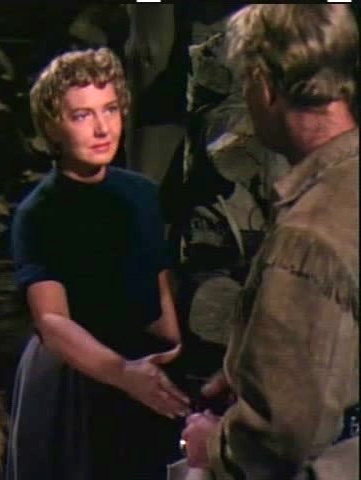
She is attractive, but not in a sexy way. She projects a warmth and love for her husband and child in the film that is completely nurturing and attractive. She extends that care and attention to Shane as well. Yes, there is a sexual tension between Mrs. Starrett and Shane, but in the end, it is resolved into motherly concern for him. Does that mean it isn’t love? Which is stronger; a woman’s love for her husband or a mother’s love for her son?
Moreover, when she tells Shane that she doesn’t want Joey to play with guns because that isn’t going to be his life, I believe she is also scolding Shane for letting guns be his life. It is a gentle, motherly scolding. She is also reminding him that she and her family are giving him a chance to start over again.
The terrible irony of the film Shane is that the only way Shane can protect these people he has come to love so deeply is to go back to being the thing they don’t want him to be.
Part Five – I know I am driving you crazy stopping it here to comment, but I have good reasons to do so.
The first thing I want you to think about is Joey. He is our witness. The boy is crouched outside the saloon, but he can see and hear everything that is happening under the swinging doors of the saloon. Inside the saloon, everyone knows what is going to happen. A cowboy quietly leaves the table and the other will soon follow. Even the dog slinks out of the room sensing what is going to happen. Shane goes through the motions of asking Riker for his offer, but they both know that there isn’t any offer and each knows the other knows this. Finally, Shane tells Riker “You’re kind of days are over”, to which Riker replies, “My days, what about yours, gunfighter”
It is the first and only time anyone calls Shane a gunfighter, even though almost everyone in the movie has known that is what he is. It has been the one thing that has gone unsaid throughout the movie. There is a superstitious belief that calling something by its true name will evoke that thing. That is why superstitious peasants don’t use the name of the Devil. They fear they may summon him. Riker has just called Shane a gunfighter.
As soon as Riker calls Shane a gunfighter, Shane loses interest in talking to Riker and turns to Wilson saying, “We haven’t heard from your friend here”. Wilson has been sitting with his coffee quietly coiled up like a snake, but listening to every word.
Earlier I said that Joey sees the world as being made up of “white hats” and “black hats” but that the conflict between his father and Riker isn’t really black and white. Joe Starrett and Rufus Riker both have good claims to the land and in history, the solution to the conflict between farmers and ranchers was that compromises were made. I also said that one reason Riker hesitates to use violence against Starrett is that he sees some of himself in Starrett. But it was Starrett who asked Shane to stay in the valley shifting the balance in favor of the farmers. Riker has responded by bringing Wilson to the valley. My question for you is this: what is Wilson? He is a gunfighter, of course, but what I want you to think about now is what he symbolizes? By the way, if you get the answer right I think you have really started to understand how symbolism works.
So, what does Wilson symbolize?
Part Six – You are not going to like the answer. Wilson is Shane. Yes, that is really disturbing. Let me explain.
Old-time religious preachers used to play a trick on children who misbehaved. It would usually be some smart aleck sixteen-year-old boy who thought he was as tough as Billy the Kid. They would tell the child that they had a picture of the true face of the devil in a book and if the child was brave enough he could open the book and see the devil’s face. Of course, the tough boy would open the book and see his own face in a mirror!
It takes a brave man to really see himself, to see his own dark side, his own shadow self. This is what Wilson is. Wilson is Shane’s own shadow. Wilson, lean and cruel and dressed in black with his one tight black glove and his sickening smile is the very image of the killer. But a killer is exactly what Shane is, too. Remember Shane’s eyes after he shot the little white rock for Joey?
In that moment Shane has the eyes of a killer. Then he is all kindness and gentleness again. Joey never saw Shane’s eyes, but we did. Throughout the film, we have had hints of what he is capable of. The fact that when Shane stands behind Mr. Starrett he isn’t the slightest bit worried about the six armed men on horseback in front of him lets us know he is brave…but it also lets us know he is deadly. Then there is the scene in the bar just before Shane and Chris Calloway fight. The cowboy sitting with Calloway says “deal me out” and leaves quickly saying, “Let’s just say I’m superstitious”. Don’t call the devil by his name. He might appear
When George Stevens chose Alan Ladd to play Shane he was doing something called “casting against type”. Ladd was a handsome man who exuded a kind of personal warmth and gentleness that was nothing like what we would expect a gunfighter to be like. We expect a gunfighter to be like…well, Wilson! They appear to be opposites, yin and yang, good and evil, light and dark.
But when it comes time to fight Wilson, Shane tells Joe Starrett that “this is my kind of game”, and it very much is Shane’s kind of game. Only Shane can fight Wilson. In fact, it is Shane’s destiny to have to fight Wilson because, in the end, the one person you cannot escape is yourself, that devil in the mirror. Let’s find out what happens when Shane faces himself.
Part 7 – The final gunfight in Shane is one of the greatest ever filmed. Compare it to the final gunfight in Stagecoach. In Stagecoach Luke Plummer wears his black hat and Ringo is in his white hat. So, we know who is the good guy and who is the bad guy. George Stevens also has Shane and Wilson in light and dark hats and clothing but goes to much greater lengths than Ford did to accentuate the contrast. Stevens also uses different lighting for each of them. Shane is bathed in a soft, golden light which accentuates his golden buckskins while Wilson is lit in a harsh white light that makes his black clothes and hat seem even blacker.
Of course, the biggest difference between Shane and Stagecoach is that Stevens is actually going to show us the gunfight, while Ford only lets us see Ringo dive to the ground firing his rifle. Strictly speaking, Ringo kind of “cheated” when he hit the ground like that. But, of course, he was also outnumbered three to one.
In contrast, the final gunfight in Shane is, in most ways, a textbook gunfight by the rules. Stevens takes far more time building up to the fight than Ford did in Stagecoach. He creates more and more tension just before the men draw by using a series of increasingly rapid cuts from one to the other, Shane…Wilson, Shane …Wilson, Shane …Wilson! Twenty-five different shots in all!
The rapid editing is in contrast to the way they both continue to talk slowly and quietly. In a gunfight only a frightened man shouts or becomes angry with his opponent. Neither of these men is frightened. They are both professionals who know exactly what they are doing. Wilson even seems to be enjoying himself.
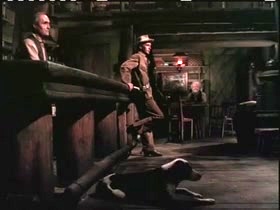
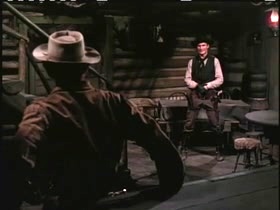
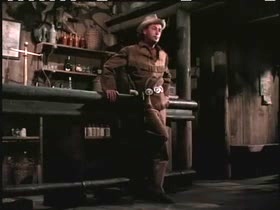
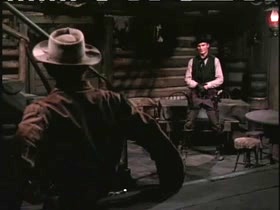
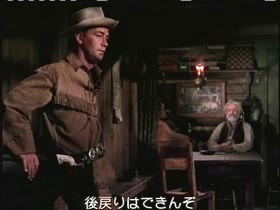
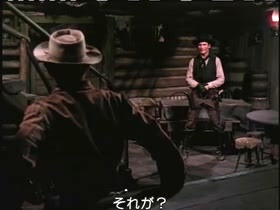
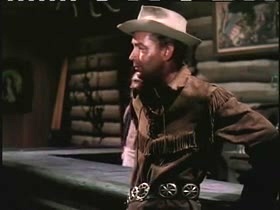
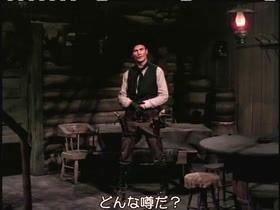
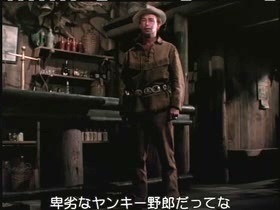
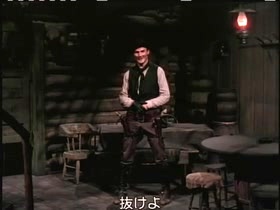
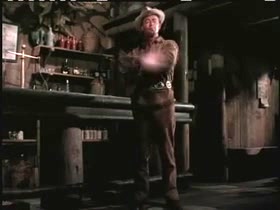
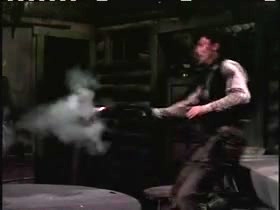
But, in order to follow the rules, they have to go through the ritual of one or the other of them offering an insult to give them a reason to draw. Shane knows what he is going to do, but he has to have an excuse to do it. So, he says he has heard of Wilson. Wilson almost pleasantly asks what he has heard. Shane then stops leaning against the bar and takes his stance (Wilson knows what this means). Shane then repeats Torrey’s words: “I’ve heard you are a no-good Yankee liar”. He is paying tribute to Torrey by saying this but he is also giving Wilson no way out. The insult is so strong and clear it is obvious Shane is telling him: “We are going to fight now” and Wilson is happy to take up the challenge by smiling and repeating what he said to Torrey, “Prove it”. There is a pause and then Wilson does the one thing you must never do in a gunfight — he draws first. Remember that in Westerns, as in jidaigeki, drawing first means you have lost your nerve, your will has broken, you have panicked. A gunfight is a test of wills and Shane has won as soon as Wilson tries to draw.
It isn’t even close. Shane is so much faster than Wilson he shoots him twice before also killing Riker who tries to draw a gun on him from the side. I doubt Wilson knew Riker would try this. Wilson is far too arrogant to believe he would need any help, but Riker was prepared to cheat if necessary and it gets him killed.
Shane then twirls his gun back into his holster. That is pure showmanship and I have to say it also seems arrogant to me. For that moment Shane is back to being the gunfighter he was determined not to be for most of the film. Remember, Riker called him a gunfighter and that is what he is when he kills Wilson and Riker and then twirls the gun back into the holster. As he starts to walk away, Joey sees Morgan with his rifle and shouts a warning to Shane. Both men fire at the same time, but it is Morgan who is killed even though he wounds Shane. Before he walks out of the saloon, Shane looks back at Wilson and the Rikers — three more dead men. Does Shane keep count of how many men he has killed?
Time for us to see the ending.
Part Eight
Shane explains to Joey that “you cannot break the mold”. He cannot change what he is. Even though he is again being kind and gentle to Joey, we have seen how easily Shane kills and then twirls his gun back into his holster. He cannot not be what he is. Yet, even though he has failed to change what he is, he has done something even more important by protecting the farmers and making the valley safe. By doing that Shane has redeemed himself. That is what this story has been about all along. Shane cannot change what he is, but he can use what he is to do something good in order to redeem himself for all the evil he has done in the past. Redemption is a tricky thing in Western films. Suddenly someone just has the chance to do something that redeems them whether it is Dallas, Doc and Hatfield helping and protecting Lucy Mallory or Shane saving the Starretts and the other homesteaders. But sometimes the price of redemption is very high. Hatfield died after all.
Shane tells Joey to tell his mother it is safe in the valley now because there will be no more guns once he is gone. Just as Shane saw his own shadow self in Wilson, I believe he also sees his younger innocent self in Joey. He does not want Joey to become what he is, he wants Joey to be like his father, Joe. He tells Joey to take care of his parents and grow up to “strong and straight”, in other words, to be a man like his father.
It is a curious thing, but like both Stagecoach and Red River, Shane has a secret. In Stagecoach, the secret was that Dallas was a prostitute while in Red River the secret was the true love between Thomas Dunson and Mathew Garth. Now we come to the secret of Shane which some of you have already figured out.
When a child watches the end of Shane they cry because they feel what Joey feels, the loss of a hero and a special best friend who “goes away” and will never come back again. But the adults in the audience saw that Shane was not just “going away”. Shane has killed Wilson, but Wilson was Shane’s shadow. Can the shadow die and the man remain alive? Shane was wounded by Morgan’s rifle shot but tells Joey he is okay. However, as you watch the very last moment of the film you see that Shane has ridden into the cemetery, the same one where Torrey was buried, and you also notice that Shane’s body is upright but stiff and unmoving…he is dead. Now you can cry, too.
